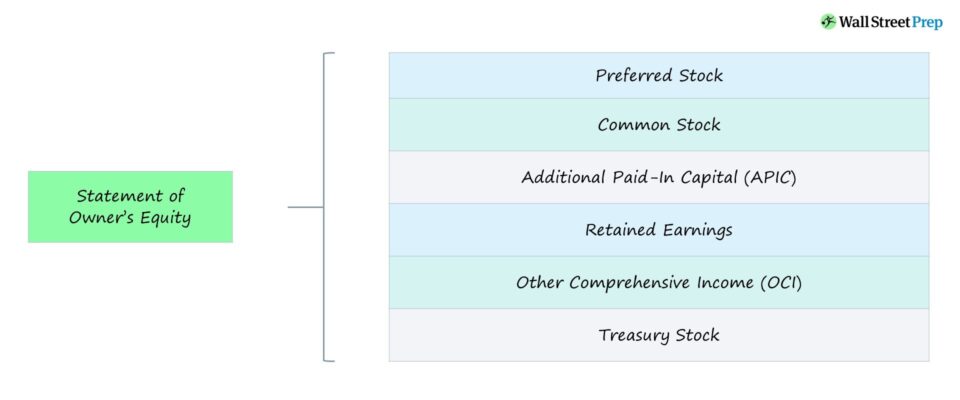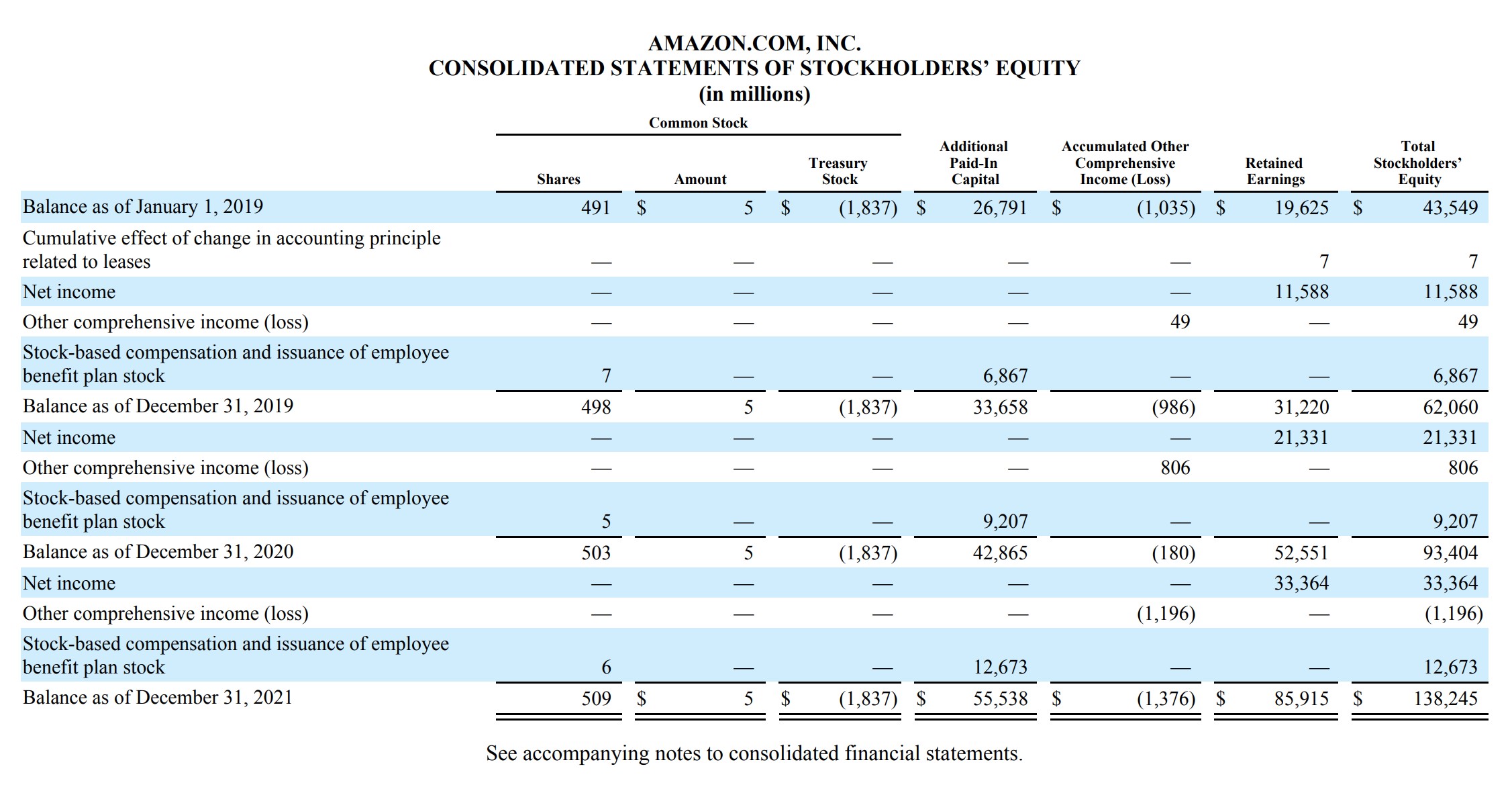- What is the Statement of Owner’s Equity?
- How to Prepare Statement of Owner’s Equity Report?
- How to Format Statement of Owner’s Equity?
- Statement of Owner’s Equity Example: Amazon Filing Report
- Statement of Owner’s Equity Calculator
- Statement of Owner’s Equity Calculation Example
- Statement of Owner’s Equity vs. Cash Flow Statement (CFS)
What is the Statement of Owner’s Equity?
The Statement of Owner’s Equity tracks the changes in the value of all equity accounts attributable to a company’s shareholders and impacts the ending shareholder’s equity carrying value on the balance sheet.

How to Prepare Statement of Owner’s Equity Report?
The statement of owner’s equity provides investors with a more detailed understanding of how each individual equity account has been specifically adjusted across different periods.
The statement of owner’s equity, also known as the “statement of shareholder’s equity”, is a financial document meant to offer further transparency into the changes occurring in each equity account.
Both U.S. GAAP and IFRS require companies to include a document that outlines the changes in all equity accounts for greater investor transparency.
The statement of owner’s equity is meant to be supplementary to the balance sheet. The document is therefore issued alongside the B/S and can usually be found directly below (or near) it.
The balance sheet — one of the three core financial statements — shows a company’s assets, liabilities, and shareholders’ equity at a specific point in time.
- Assets → The resources belonging to a company that either holds monetary value (e.g. cash and cash equivalents) or can contribute to future economic value creation (e.g. property, plant and equipment)
- Liabilities → The unmet obligations of a company that represents a funding source for the company to finance its purchases of assets, and thus these liabilities are future outflows of cash (e.g. accounts payable, accrued liabilities, debt).
- Shareholders’ Equity → The other funding source besides liabilities that captures the capital contributed by investors (i.e. equity issuances to raise capital), retained earnings, share buybacks, and dividends, among others.
There are limitations to the balance sheet (and thus, the income statement, too), thus supplementary disclosures aim to provide investors and all applicable parties with more details, i.e. a more in-depth understanding of the movement of the shareholders’ equity carrying amount on the B/S.
How to Format Statement of Owner’s Equity?
The list below defines the most common items that appear in the statement of owner’s equity:
- Preferred Stock → A special ownership stake in the company that provides holders with a higher claim on a company’s earnings than common stockholders. They have a higher claim to dividends or asset distribution. Companies report preferred stock at par value, which is the issued or redeemable amount. Preferred stockholders have no voting rights in the company. This type of stock appeals to investors who desire stability and predictability in future dividends.
- Common Stock→ Represents ownership in a company. Stockholders possess voting rights about company decisions, such as electing a board of directors and voting on policies. Common stockholders can earn more than preferred stockholders but are also the lowest-priority claim on a company’s assets. In the event of liquidation, common stockholders will get paid after preferred stockholders.
- Additional Paid-In Capital (APIC) → Often consolidated with the “Common Stock” line item in a financial model, APIC depicts the excess amount that investors have paid for stock issuances over the stated par value.
- Retained Earnings → The retained earnings line item represents a company’s accumulated earnings to date, which were kept by the company for reinvestments (i.e. working capital and capital expenditures), rather than distributing those profits to shareholders in the form of dividends.
- Other Comprehensive Income (OCI) → The OCI account records the accumulated revenues, expenses, and gains (or losses) that have not yet been realized. Until the activity is formalized (e.g. an investment is liquidated and converted into cash), the amount remains in the OCI account.
- Treasury Stock → Share buybacks are used by companies seeking to compensate shareholders. A company’s repurchased shares are recorded as treasury stock and are no longer trading in the open markets post-buyback. The treasury stock account — considered a contra-equity account — then decreases by the amount used to repurchase treasury stock.
- Non-Controlling Interests → NCI, or “minority interests”, refer to ownership stakes in a subsidiary’s equity that are not owned or controlled by the parent company, i.e. the ownership interest is less than 50% of the outstanding shares with no direct control over the subsidiary’s decisions.
Statement of Owner’s Equity Example: Amazon Filing Report
Based on the reporting guidelines established by U.S. GAAP, the supplementary report is set up in a grid-like pattern.
- Beginning Balance → Normally the beginning equity account and shareholders’ equity balances are first stated in the far left column.
- Equity Components → Each of the components that impact the equity account is listed in the top row, with the corresponding change listed below.
- Ending Balance → From top to bottom, the changing amounts are reported in blocks ordered in ascending order from least recent to most recent, until reaching the ending balance for the period on the right section.
As an illustrative example, below is the statement of stockholders’ equity for Amazon (AMZN) during the fiscal year ending 2021.
The starting line item is the beginning balance as of January 1, 2019, and from there, a breakdown of all of the changes in Amazon’s equity accounts between current and prior accounting periods are reflected.
Amazon Statement of Stockholders’ Equity Example (Source: Amazon 10-K)
Statement of Owner’s Equity Calculator
We’ll now move to a modeling exercise, which you can access by filling out the form below.
Statement of Owner’s Equity Calculation Example
Suppose a company’s equity accounts on January 1, 2020, the start of its fiscal year 2020, consists of the following.
- Common Shares (#) = 100 million
- Common Stock ($) = $12 million
- Treasury Stock ($) = – $2 million
- Additional Paid in Capital (APIC) = $6 million
- Retained Earnings = $10 million
By adding each of the columns on the left — excluding the number of shares — the owner’s equity at the beginning of 2020 is $26 million.
The following changes occurred in the equity accounts throughout 2021.
- Net Income = $8 million
- Issuance of Common Stock = 10 Shares with $1 million to Common Stock (and $9 million in Excess Over Par)
- Cash Dividend Issuance = ($2 million)
In terms of the balance sheet values, we’ll start with retained earnings.
Since the beginning balance was $10 million, net income was $8 million, and the cash dividend was $2 million, the ending balance is $16 million
- Ending Retained Earnings = $10 million + $8 million – $2 million = $16 million
For the additional paid-in capital (APIC) account, the beginning balance was $6 million and the impact from the issuance of common stock in the period, i.e. the excess amount paid over par, was $9 million, so the ending balance is $15 million.
- Ending Additional Paid-In Capital (APIC) = $6 million + $9 million = $15 million
From 2020 to 2021, the company’s share count rose from 100 to 110, the common stock amount increased from $12 million to $13 million, the treasury stock account remained constant, APIC increased from $6 million to $15 million, and retained earnings increased from $10 million to $16 million.
- Common Shares (#) = 110 million
- Common Stock ($) = $13 million
- Treasury Stock ($) = – $2 million
- Additional Paid-In Capital (APIC) = $15 million
- Retained Earnings = $16 million
Our table specifically details what changes contributed to our hypothetical company’s owner’s equity account increasing from $26 million to $42 million.
- Ending Owner’s Equity = $13 million – $2 million + $15 million + $16 million = $42 million
Statement of Owner’s Equity vs. Cash Flow Statement (CFS)
The difference between the statement of owner’s equity and the cash flow statement (CFS) is that the former portrays the changes in a company’s equity over a period in more detail.
In contrast, the cash flow statement — or statement of cash flows — tracks the changes in a company’s cash and cash equivalents over a period of time.
All financial statements are closely linked and supplemental disclosures are meant to ensure there is no misunderstanding from investors.
The statement of owner’s equity essentially displays the “sources” of a company’s equity and the “uses” of its equity.
- Sources (“Inflow”) → Paid-In Capital, Additional Paid in Capital (APIC), Retained Earnings
- Uses (“Outflow”) → Shareholder Dividends, Stock Buybacks (Share Repurchases)
On the other hand, the cash flow statement is more about tracking the movement of a company’s cash and cash equivalents across a specified period and is comprised of three distinct sections:
- Cash Flow from Operations Activities (CFO)
- Cash Flow from Investing Activities (CFI)
- Cash Flow from Financing Activities (CFF)
The cash flow statement (CFS) is, therefore, more comprehensive with regard to understanding the financial health of a company, but does not offer the same type of transparency into any specific line item.

Everything You Need To Master Financial Modeling
Enroll in The Premium Package: Learn Financial Statement Modeling, DCF, M&A, LBO and Comps. The same training program used at top investment banks.
Enroll Today







